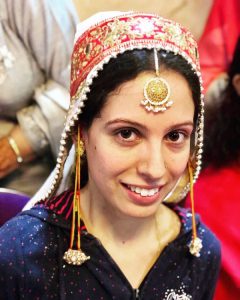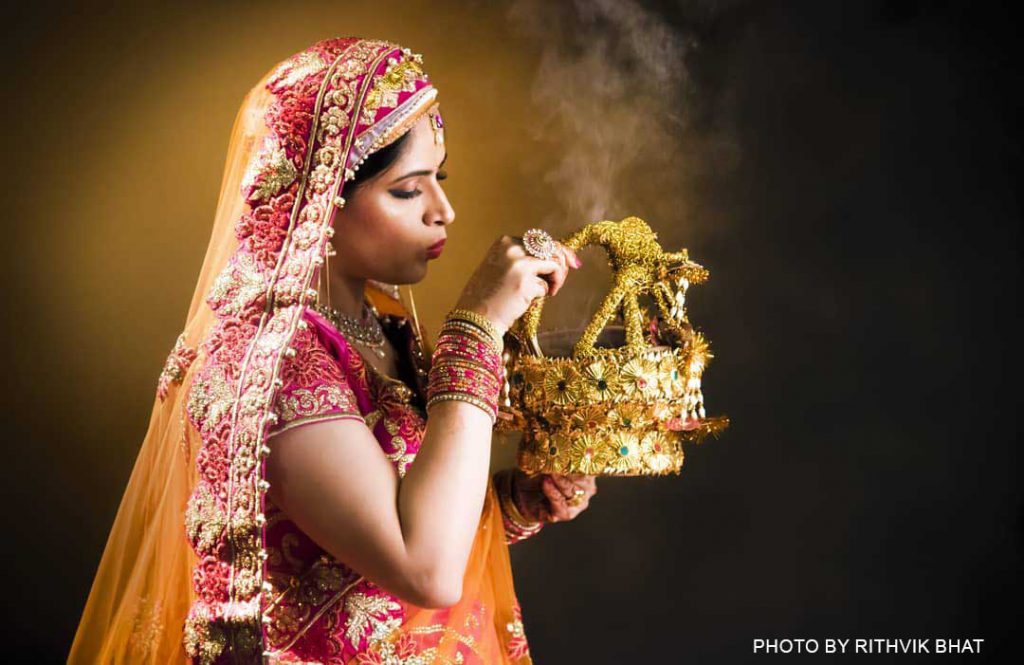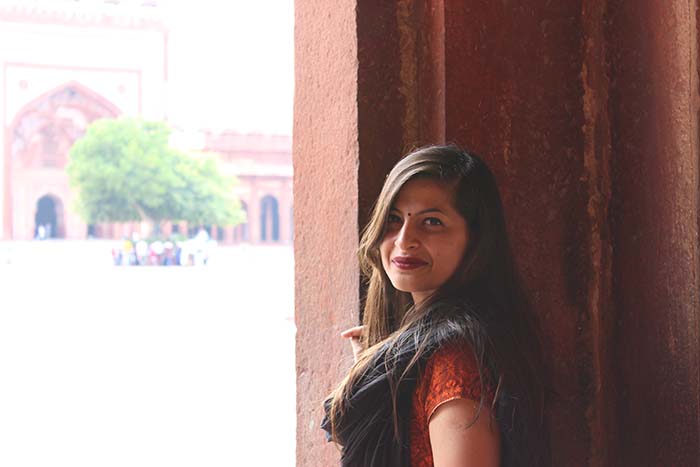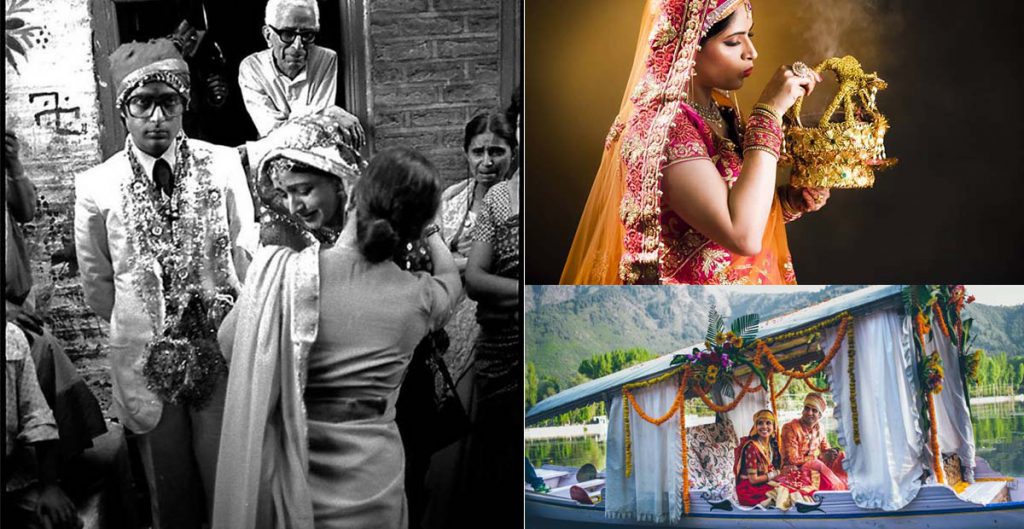Blog, Kashmiri Culture, Weddings in Kashmir
Here’s Everything You Need to Know About a Kashmiri Pandit Wedding
Here’s Everything You Need to Know About a Kashmiri Pandit Wedding
Weddings are quite an elaborate affair, and Kashmiri weddings are more so!
The seemingly never-ending list of pre-wedding, wedding, and post-wedding functions is something most Kashmiris are familiar with. And that’s what makes the amalgam of love, beauty and families (or simply, marriage), more fun-filled in our tradition.
In case you are thinking, how elaborate it can get – read on
From Devgaon to Mehendiraat, Kashmiri marriages constitute fresh flowers, delectable dishes, custom ornaments, and a lot of mingling of the bride and groom’s families. The festivities are spaced out over more than a week, making it nothing short of a wedding extravaganza.
Here I will explain in detail some of the most typical rituals of a Kashmiri wedding.
Pre-wedding rituals
1. Livun – Pronounced as ‘li-vun’ comprises of properly cleaning the houses of the groom as well as that of the bride’s. It’s an auspicious day determined by the pundit before the wedding. Later, the houses are adorned with beautiful flowers – this simple ritual is referred to as ‘krool khanun’ in Kashmiri households. It gives the house a very festive look and feel.

2. Maenziraat – Or simply, Mehendiraat. The day the girl’s hands and feet are adorned in intricate designs with henna paste. Just before this, the bride’s maternal uncle and maternal aunt wash the feet of the bride in a one of-a-kind bathing ritual. This small ritual occupies a very special place in our hearts, as it gets captured in not just our memories, but also in our cameras! The celebration spills into the night with the elderly singing Kashmiri folk songs, everyone dancing and an occasional serving of ‘kehwa’ or Kashmiri tea, mostly during winters, to add flavor to the function.
3. Devgaon. Haldi ritual – It marks the perfect time to rub haldi on the bride’s face and arms with love and affection. From the maharani’s (bride in Kashmiri) brothers and sisters to her maternal and paternal aunts, all lather haldi paste on the bride. The exact same order is also followed on the groom’s side. Later, as part of the bathing ritual, buckets of cold water mixed with curd are poured onto the bride through a linen type cloth. Immediately after this, both the bride and groom change into new clothes before puja. The duo observes a fast for this particular day. The bride is showered with jewellery from members of the family, along with new suits and sarees.

The Wedding Day
4. Wedding – is most commonly called as ‘Lagan’ in Kashmiri. On the big day, the groom’s family is given a rousing welcome, as families greet each other and exchange nutmeg. It symbolizes the acceptance of the relationship. Conches are blown before the groom steps into the house. The ‘auspicious hour’ or ‘auspicious’ time or ‘muhurat’ is usually decided for after midnight. While Kashmiri pandit weddings comprise of 7 pheras, even before calling in the groom, the priest does some puja at the mandap, followed by dwar puja. After this the kanyadaan takes place, followed by the customary 7 pheras (chakkars). The hands are covered in a special cloth called “Athwas”, while a golden thread is tied to their foreheads. ‘Saptapadi’ is another ritual in which the couple take seven symbolic steps, while announcing the seven marriage vows. This is the symbolic beginning of their journey together. Throughout the ceremony, the groom holds the bride’s hands tightly.
5. Posh Puja (Flower shower or flower puja) – Another interesting bit in the long list of Kashmiri wedding functions is the flower shower. In this, a red cloth is placed over the couple’s heads, who are sitting close together. As Vedic mantras are recited, family and friends shower flower petals on the, now, almost-married couple.

Post-wedding rituals
6. Fun and games – Once the couple has tied the knot, comes the fun part. The newlyweds are now engaged in small, little fun games, such as finding a ring from a pot of rice and also feeding each other from a thaali consisting of Kashmiri veg delicacies – dum aloo, chaaman (paneer). This moment is special and has the photographers swarming around the just-married couple.
7. Vidaai – Just before departure, the newlyweds are made to stand on a wooden pedestal, called ‘vyoog’. This as the eldest female member of the bride’s family, kisses them on the forehead. And just after this the atmosphere turns emotional, where the bride hugs her parents, all the members of her family– before throwing a handful of raw rice over her shoulder, praying for the long prosperity of her paternal home. She also carries a handful to be scattered at the doorstep of her new home.
8. Welcoming the bride at her in-laws house – The bride receives a warm welcome at her new house. Just before stepping into the house, the couple is fed some nabad and the threads tied on both of their heads are exchanged. This is usually followed by some chatter, where the newlyweds are teased and the bride is introduced to more members of the groom’s family.
9. Saatraat – The couple is accompanied by one or more kids during this ritual, when the duo visit the bride’s home. There she is presented with new clothes, which according to ritual, are to be worn by the girl before returning to the groom’s house. The couple also enjoy a lavish meal during their visit.
10. Phirlath – In this simple ceremony, the bride’s parents arrive at the newlyweds with more gifts, where they are treated to a lovely meal by their new in-laws.
11. Ghar Atchun – It is pronounced as “gaar atchun”, where the word ‘gaar’ means ‘ghar’ or house, and ‘atchun’ means ‘to enter’. It is a formal reception hosted by the bride’s side. The bride and groom arrive wearing new clothes. The meals served to the guests on this day are strictly vegetarian. In a separate reception, which is organized by both families, the spread has authentic Kashmiri non-vegetarian delicacies too. This concludes the week-long wedding celebrations.
Shop for Kashmiri wedding here
About the writer Rupal Raina

I am Rupal and am a Kashmiri Pandit girl living in Delhi. I love to write and meet new people. Writing is a way to give my thoughts an expression, that engages with people. I am a lover of all things art, technology, and most essentially unique ideas. I am also a yoga enthusiast. You’ll always find me on my yoga mat, trying to make up for a bad day ( when I have one)!




